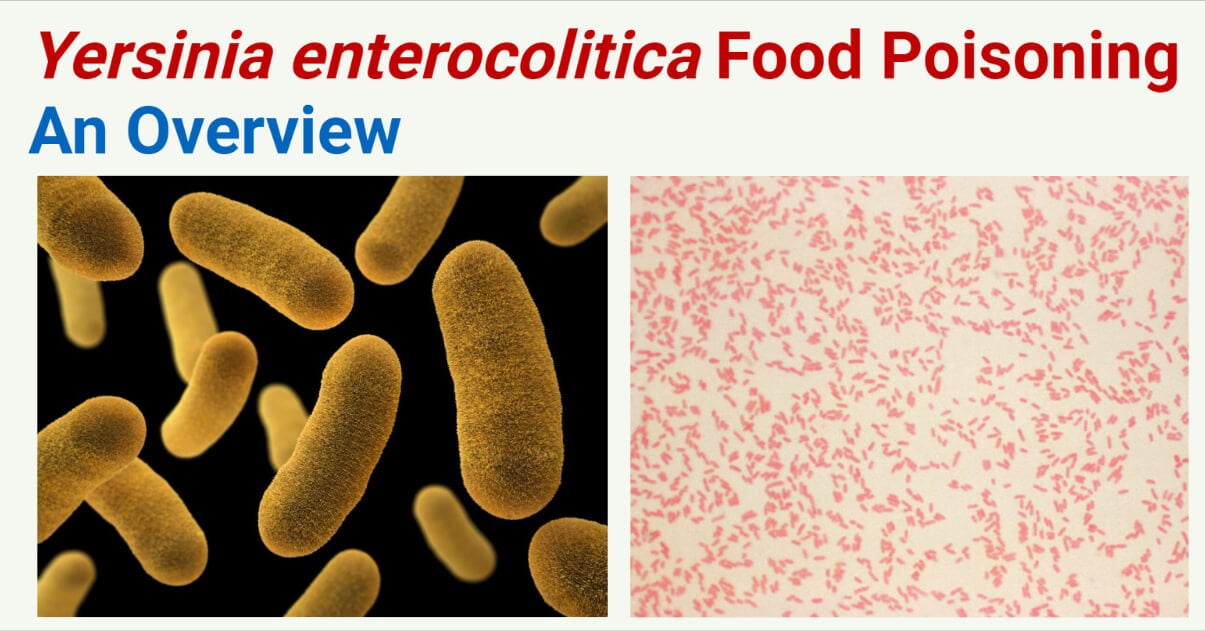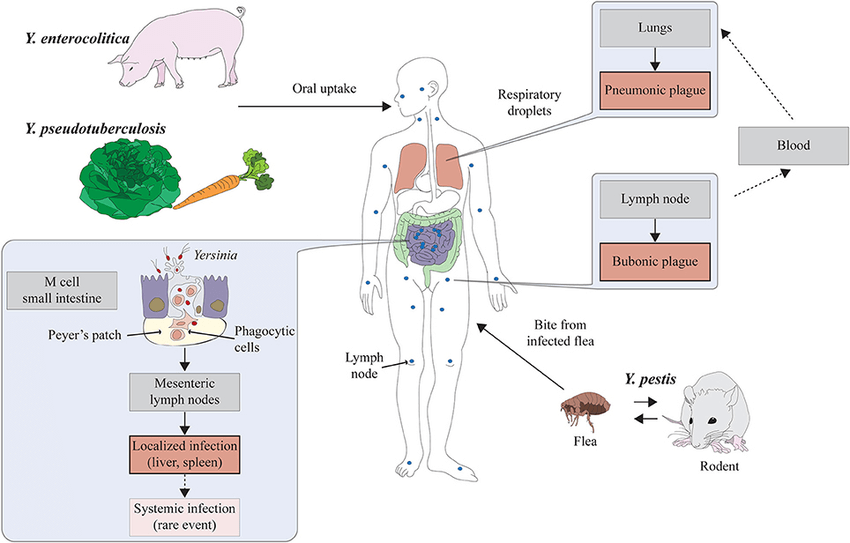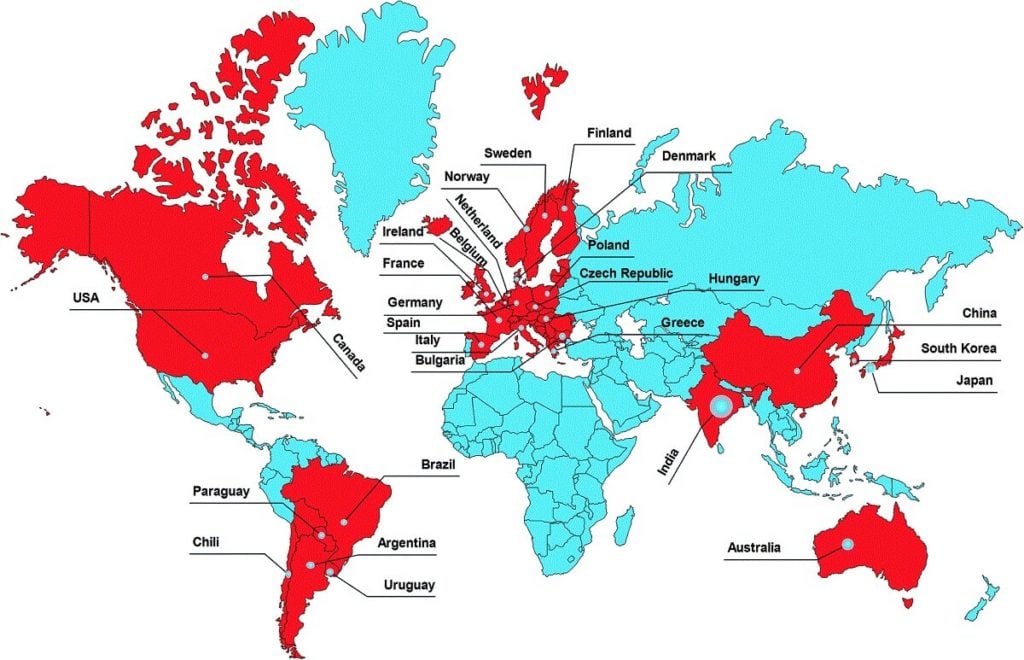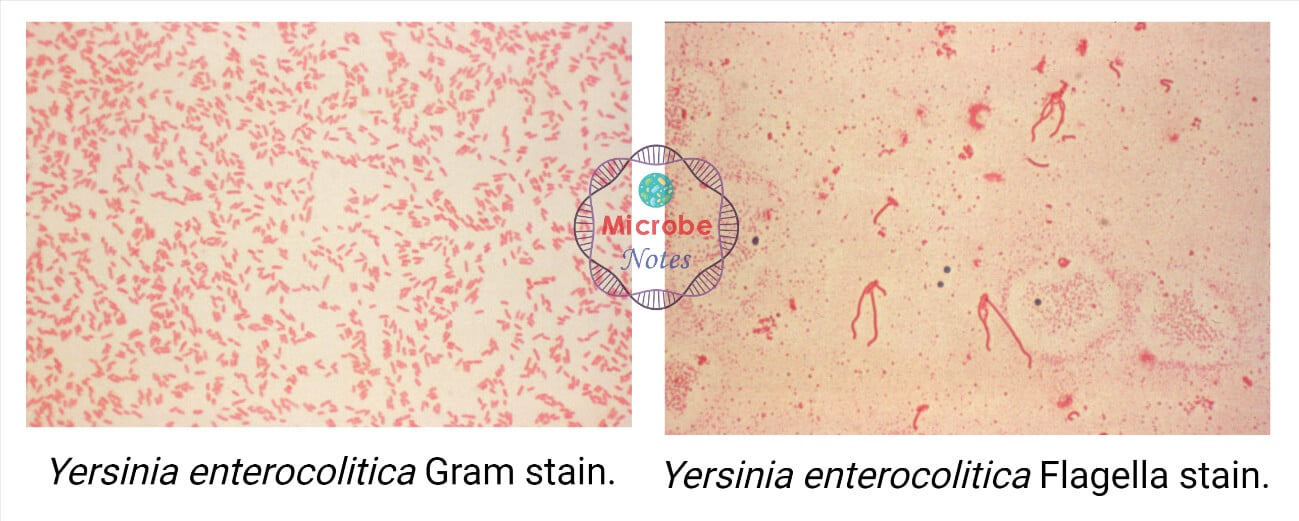Yersinia enterocolitica is a pathogenic species belonging to the Enterobacteriaceae family that causes diseases like acute gastroenteritis and yersiniosis.
After Campylobacter and Salmonella species infection, Yersinia enterocolitica is the third common enteric pathogen that causes foodborne disease and human yersiniosis infections.
Y. enterocolitica and Y. pseudotuberculosis are enteropathogenic, while Y. pestis is transmitted by flea vector and causes bubonic plague.

These organisms are isolated from animals mainly swine and can be found in a variety of foods and environments.
Most cases of yersiniosis are sporadic and young children under five years of age and infants are highly susceptible groups.
The foodborne outbreak has rarely occurred in some developed countries like Japan and The Netherlands and developing countries like Bangladesh and Iraq that lie in the temperate zone.
Yersinia enterocolitica is present everywhere and can even survive at refrigeration temperature, which has led to many complications of yersiniosis infection in humans all around the world.
The prevalence of yersiniosis is important to determine by identifying its potential source, transmission routes, pathogenesis, method of detection, and preventive measures.
Interesting Science Videos
Characteristics of Yersinia enterocolitica
- Gram-negative
- Non-spore forming bacillus
- Psychrotrophic enterobacteria
- Oxidase negative
- Catalase positive
- Facultative anaerobic rods or cocobacilli
- Non-capsulated
- Motile (except Y. pestis)
- Grows at 5% NaCl concentration
- pH range from 4 to 10

Source of contamination of Yersinia enterocolitica Food Poisoning
- Pigs are reported to be the primary reservoir of Yersinia enterocolitica, and other sources include food, water, sewage, and animals like cattle, sheep, goats, and rodents.
- The organism is present in the oral cavity of pigs like in tonsils, intestines, feces, and lymph nodes which causes cross-contamination with other products.
- Ruminants, poultry, vegetables, milk and milk products, ready-to-eat foods, and chitterlings are also possible sources of yersiniosis infection.
Signs and Symptoms of Yersinia enterocolitica Food Poisoning
- Symptoms usually appear within 24 to 30 hours of ingestion with predominantly gastrointestinal symptoms like diarrhea, vomiting, nausea, fever, and lower right side abdomen pain mimicking appendicitis.
- It also causes joint pain (reactive arthritis), skin rash (erythema nodosum), enterocolitis, mesenteric lymphadenitis, and terminal ileitis among adults.
- The severity of infection depends on an individual’s age group and physical state.
- The infection may last for 3 to 28 days in infants and 1 to 2 weeks in adults.
- But the disease can be fatal in immunocompromised individuals causing death in the severe case of septicemia, pneumonia, meningitis, and endocarditis.
Pathogenic Mechanism of Yersinia enterocolitica Food Poisoning

- Yersinia enterocolitica is transmitted orally, and about 107 to 109 cells are required to cause an infection.
- After ingestion, the bacteria travel through the stomach and reach the small intestine, and colonize in the terminal ileum and proximal colon.
- It also penetrates inside the mucosal layer of the intestine and infects the tissue as the strains of pathogenic Yersinia enterocolitica can resist non-specific immune responses.
- Y. enterocolitica contains a 70-kb virulence plasmid (pYV) that helps organisms to replicate within lymphoid tissue.
- The pYV genes are influenced by the optimum temperature at 37°C and low calcium concentration.
- The attachment invasion locus (Ail) protein of the pathogen is involved in the attachment and invasion to host cells and protects bacteria against host immune responses.
- YadA (Yersinia adhesion A) promotes replication of bacteria in Payer’s patches and forms abscesses causing inflammation of joints.
- Bacteria are then spread from Payer’s patches to the liver, spleen, lungs, and lymph nodes causing characteristic lymphadenitis.
- A heat-stable Yst enterotoxin promotes fluid secretion and the membrane-bound guanylate cyclase is stimulated by three components of Yst (Yst-A, Yst-B, and Yst-C).
- These components activate the intracellular cyclic guanosine monophosphate (cGMP) and cGMP-dependent protein kinase resulting in inhibition of Na+ absorption and stimulating Cl– secretion.
Epidemiology of Yersinia enterocolitica Food Poisoning

- Yersinia enterocolitica outbreak has increased in recent years, which was associated with the consumption of highly risked raw meat, fruits, and vegetables.
- Many studies have reported that yersiniosis is linked primarily with the consumption of raw and undercooked pork meat.
- In European Union, over 7000 yersiniosis cases were reported and among them, 98% cases were caused by Y. enterocolitica but the fatality rate was low about 0.02%.
- Children under 5 years are at high risk in Lithuania and Finland which were the highest reported countries reporting 10 to 11 cases per 100,000 populations.
- The most common serotype of Y. enterocolitis associated with human infection is Y. enterocolitica bioserotype 4/O:3.
- In Malaysia, the first case of Yersinia bioserotype was isolated from a 34-year-old female who caused an infection after consuming beef burger and chicken burger meats.
- But the actual incidence is limited, and the cause of yersiniosis is still unknown.
- Many yersiniosis cases are still unknown due to the high genetic similarity among Yersinia enterocolitica strains and the inconsistency of surveillance systems.
Detection methods of Yersinia enterocolitica

- Culture methods using media such as MacConkey agar, Hektoen-Enteric (HE) agar, and Xylose-lysine-deoxycholate (XLD) agar increase the bacterial number.
- Modified cefsulodin-irgasan-novobiocin (CIN) agar is the most effective selective media differentiating Yersinia enterocolitica from other species.
- Bioassays using mice and rabbits are also used to determine the activity of Yersinia enterotoxin (Yst).
- Serological tests using agglutination-based serodiagnosis have been used but were not effective due to cross-reaction of the antiserum with other pathogens.
- Indirect immunofluorescence assay and ELISA methods diagnose a patient suffering from yersiniosis.
- Molecular detection methods such as PCR, RT-PCR, multilocus enzyme electrophoresis (MLEE), Pulsed-field gel electrophoresis (PFGE), amplified fragment length polymorphism (AFLP), randomly amplified polymorphic DNA (RADP), and DNA ribotyping has been widely used nowadays.
Treatments of Yersiniosis
- Proper nutrition and oral rehydration is the primary treatment in case of yersiniosis.
- The disease is self-limiting and requires no antibiotic therapy.
- But in severe cases, antibiotics like aminoglycosides and trimethoprim-sulfamethoxazole (TMP-SMZ) may be useful.
- Broad-spectrum cephalosporins are also effective against extraintestinal infection.
Prevention and Control of Yersiniosis
- Being a psychrotrophic bacteria, storing food at refrigeration temperature cannot control their growth.
- Raw milk and undercooked meat should be avoided.
- Maintaining good sanitation during slaughtering and handling of raw meat products, especially swine products.
- Yersinia species are heat sensitive and can be easily destroyed by pasteurization, UV radiation, and other heat treatment preservation methods.
References
- Bari, M. L., Hossain, M. A., Isshiki, K., & Ukuku, D. (2011). Behavior of Yersinia enterocoliticain Foods. Journal of Pathogens, 2011, 1–13.
- Tan, L. K., Ooi, P. T., & Thong, K. L. (2014). Prevalence of Yersinia enterocolitica from food and pigs in selected states of Malaysia. Food Control, 35(1), 94–100.
- Joutsen, S., & Fredriksson-Ahomaa, M. (2016). Yersinia enterocolitica: Properties and Occurrence. Encyclopedia of Food and Health, 606–611.
- Xanthopoulos, V., Tzanetakis, N., & Litopoulou-Tzanetaki, E. (2010). Occurrence and characterization of Aeromonas hydrophila and Yersinia enterocolitica in minimally processed fresh vegetable salads. Food Control, 21(4), 393–398.
- Fàbrega, A., & Vila, J. (2012). Yersinia enterocolitica: Pathogenesis, virulence and antimicrobial resistance. Enfermedades Infecciosas y Microbiología Clínica, 30(1), 24–32.
- Ahmed, H. A., Tahoun, A. B. M. B., Abou Elez, R. M. M., Abd El-Hamid, M. I., & Abd Ellatif, S. S. (2019). Prevalence of Yersinia enterocolitica in milk and dairy products and the effects of storage temperatures on survival and virulence gene expression. International Dairy Journal.
- Heroven AK and Dersch P (2014) Coregulation of host-adapted metabolism and virulence by pathogenic yersiniae. Front. Cell. Infect. Microbiol. 4:146. doi: 10.3389/fcimb.2014.00146.

Y enterocolitica does not cause plague. Y pestis does. Plz correct your info
Hi, thanks for the correction. The page has been updated. 🙂